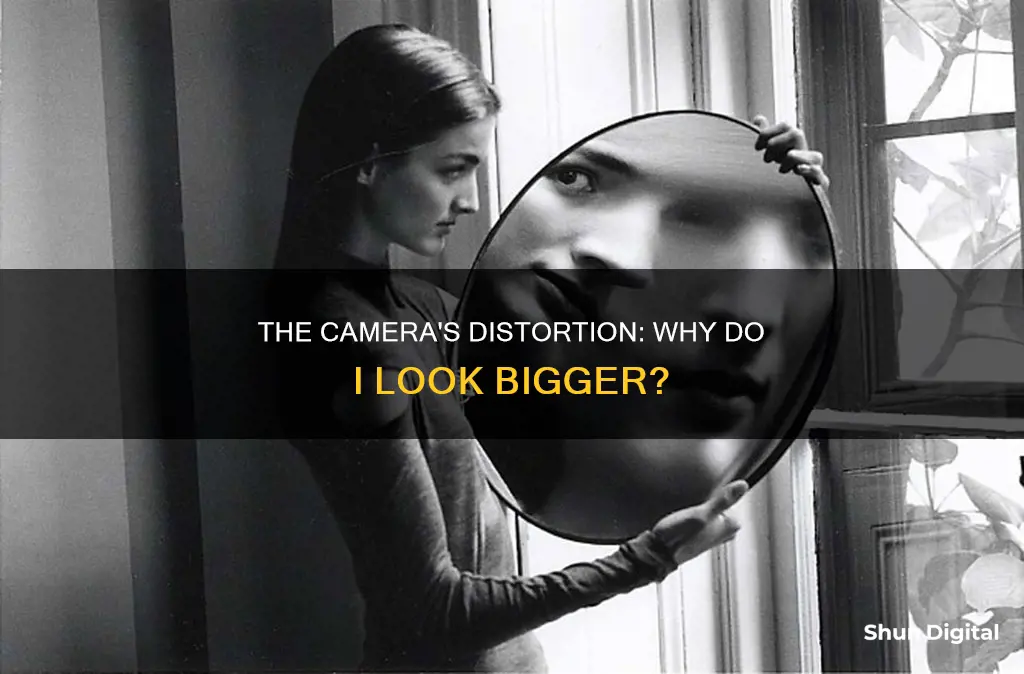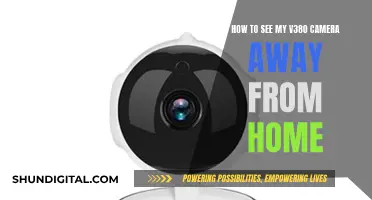
Many people are concerned about the way they look in photographs, especially when they feel they appear larger than they do in real life. This phenomenon is not just in your head; it is a result of several factors, including camera lens width, angles, and focal length, which can distort features and expand the width of faces and bodies.
Other factors that can contribute to this effect include clothing choices, posture, and posing. For example, wearing horizontal stripes can have a 'widening' effect, while vertical stripes can make you look taller and thinner. Additionally, slouching can minimise your overall length and make you look stockier.
| Characteristics | Values |
|---|---|
| Camera lens width | Wide-angle lenses can make you look bigger. |
| Camera angle | A camera angle from below can make your forehead look bigger. |
| Camera distance | Being too close to the camera can make you look bigger. |
| Posture | Slouching can make you look shorter and stockier. |
| Clothing | Baggy clothing can make you look bigger. |
| Body shape | A person's bone structure and body shape can make them look different in photos. |
What You'll Learn

Camera lens width, angles, and focal length can distort features and widen faces and bodies
The camera lens width, angles, and focal length can distort features and widen faces and bodies. The width of the camera lens is one of the most significant factors in determining how you will appear in photographs. Since wide-angle lenses produce more distortion, you might end up looking bigger than you are. Wide-angle lenses have a wide field of view, which can make things that are close to the camera appear larger than they are. This is similar to how objects in a car's passenger-side mirror appear closer than they are due to the convex shape.
The focal length of a lens determines the angle of view. A narrower focal length will provide a more tapered view. For example, an 85mm lens is narrower and longer than a 35mm lens, resulting in a more flattering portrait. Depending on the focal length, there will be lens distortions that can make subjects appear thinner or larger while flattening distinctive facial features.
The angle of the camera can also affect how your face and body appear in photographs. For instance, taking a photo from below your face can make your forehead look larger.
Additionally, the distance between you and the camera can impact how you look in photos. Experts recommend shooting from at least five feet away to avoid perspective distortion. Moving closer to the subject, such as from four feet away, can cause substantial distortion, making noses look wider, eyes appear closer together, and foreheads expand, resulting in a chubbier-looking face.
Exploring Intel RealSense Camera Data with ROSlaunch
You may want to see also

Poor posture can make you look shorter and stockier
The way you position your body while sitting, walking, sleeping, or standing can have a strong impact on how tall you appear. By standing straight with your shoulders back and your head held high, your neck will follow suit, elongating your frame for a taller, thinner appearance.
Good posture has many benefits. It can make you look more confident, alleviate stress and pain in your neck and back, and change your physical height. A straight back will allow you to stand as much as two inches taller.
- When walking, keep your back straight, head up, and shoulders down and widened out. Avoid wearing heavy items when carrying a bag.
- When sitting, keep your back straight and avoid slouching.
- While standing, spread your legs and keep your hands close to your body. Avoid putting your hands in your pockets, as this can lead to slouching.
Cameras Behind the Scenes of End of Watch
You may want to see also

Clothing choices can affect how your body looks
Clothing choices can significantly impact how your body looks on camera. Here are some tips to help you look your best:
- Avoid chunky, heavy layers that can hide your body's natural shape and make you appear bulkier. Opt for fitted clothing that accentuates your frame and highlights your curves.
- Pay attention to patterns. Horizontal stripes can create a 'widening' effect, making your body appear broader. On the other hand, vertical stripes can elongate your silhouette and make you seem thinner and taller.
- Balance loose-fitting tops with fitted bottoms and vice versa. This will help create a more defined silhouette and prevent you from looking drowned in your clothes.
- Consider the colours you wear. Monochrome outfits or colour-blocking can create a slimming effect.
- Avoid low-waisted pants, as they tend to be unflattering for most body types. Instead, opt for high-waisted bottoms that accentuate your waist and create an hourglass figure.
- Choose the right accessories. Belts, waist-cinching tops, or dresses that nip in at the waist can help define your figure and give the illusion of a slimmer waistline.
- Avoid baggy, oversized clothing from head to toe. While comfort is essential, too much fabric can make you appear larger than you are.
- Remember, these are just guidelines. Feel free to experiment and break the rules if you feel comfortable and confident in what you're wearing. Confidence is key!
Blender Camera Viewing: A Step-by-Step Guide
You may want to see also

The angle of the camera can change how your face looks
The angle of the camera can significantly impact how your face looks in a photo. A photo taken from below your face can make your forehead appear larger, while a photo taken from the side can change the shape of your face. For example, if the camera is above you and looking down, your face will appear wider.
The angle of the camera can also affect the lighting of a photo, which can impact how your face looks. Flat lighting can make your face appear wider, while shadows can thin your face.
Additionally, the angle at which you hold your phone can also impact how your face looks in a selfie. Phone cameras tend to have wide lenses, which can distort your features and make them look larger than they are. Using the rear-facing camera and holding your phone farther away from your face can help to reduce this distortion.
Fargo TV Show's Camera Equipment: Behind the Scenes
You may want to see also

Body dysmorphia can skew self-perception
Body dysmorphic disorder (BDD) is a mental health condition that causes an individual to become overly preoccupied with perceived flaws in their appearance, which are often minor or non-existent to others. This can significantly distort one's self-perception, leading them to fixate on and misinterpret images of themselves. For example, an individual with BDD might believe that their face is hideous and spend hours each day engaging in "mirror checking," or obsessively examining their reflection.
BDD is not the same as having negative body image or low self-esteem. Unlike individuals with negative body image, who are generally unhappy with their body size or shape, people with BDD are struggling with an over-emphasis on a specific body part. BDD is an obsessive-compulsive disorder characterised by uncontrollable, obsessive thoughts. It is a debilitating disorder that can have severe consequences, with 45 to 70 percent of individuals with BDD reporting suicidal ideation and 22 to 24 percent attempting suicide.
When it comes to cameras and photography, the way that a person with BDD perceives themselves in photos can be influenced by their condition. Mirrors and photographs can present slightly different versions of oneself due to lighting, angles, and lens distortions. However, for someone with body dysmorphia, these slight differences can be magnified in their perception, leading to a skewed self-image. This means that a person with BDD might perceive themselves as looking much different in photos compared to their reflection, even if the discrepancies are minimal.
It is important to note that BDD is a serious mental health disorder that requires professional treatment. If you or someone you know is struggling with BDD, seeking help from a healthcare professional is crucial.
Using iMac Camera: How to View Yourself
You may want to see also







